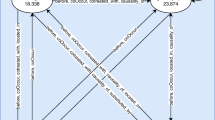Abstract
Various data mining methods have been developed last few years for hepatitis study using a large temporal and relational database given to the research community. In this work we introduce a novel temporal abstraction method to this study by detecting and exploiting temporal patterns and relations between events in viral hepatitis such as “event A slightly happened before event B and B simultaneously ended with event C”. We developed algorithms to first detect significant temporal patterns in temporal sequences and then to identify temporal relations between these temporal patterns. Many findings by data mining methods applied to transactions/graphs of temporal relations shown to be significant by physician evaluation and matching with published in Medline.
Similar content being viewed by others
References
Allen, J., “Maintaining Knowledge About Temporal Intervals,” Communications of the ACM, 26(11), pp. 832–843, 1983.
Allen, J., “Time and Time Again: The Many Ways to Represent Time,” Int. J. Intelligent Systems, 6(4), pp. 1–14, 1991.
Balaban, M., Boaz, D. and Shahar, Y., “Applying temporal abstraction in medical information systems,” Annals of mathematics, computing and teleinformatics 1(1), pp. 56-64, 2003.
Bellazzi, R., Larizza, C., Magni, P., Monntani, S. and Stefanelli, M., “Intelligent Analysis of Clinic Time Series: An Application in the Diabetes Mellitus Domain”, Intelligence in Medicine, 20, pp. 37–57, 2000.
Bruzzese, D. and Davino, C., “Statistical Pruning of Discovered Association Rules”, Computational Statistics 16 (3), pp. 387–398, 2001.
Chittaro, L., Montanari, A., “Temporal representation and reasoning in artificial intelligence: Issues and Approaches”, Annals of Mathematics and Artificial Intelligence 28, pp. 47–106, 2000.
Das, G., Lin, K.I., Mannila, H., Renganathan, G., Smyth, P., “Rule discovery from time series” ACM Int. Conf. on Knowledge Discovery and Data Mining KDD’98, pp. 16–22, 1998.
Hirano, S., Tsumoto, S., “Mining Similar Temporal Patterns in Long Time-series Data and Its Application to Medicine”, IEEE Int. Conf. on Data Mining ICDM’02, pp. 219–226, 2002.
Ho, T.B., Nguyen, T.D., Kawasaki, S., Le, S.Q., Nguyen, D.D., Yokoi, H., Takabayashi, K. , “Mining Hepatitis Data with Temporal Abstraction,” ACM Int. Conf. on Knowledge Discovery and Data Mining KDD’03, pp. 369–377, 2003.
Hoppner, F., “Learning dependencies in multivariate times series,” the ECAI’02 Workshop on Knowledge Discovery in (Spatio)-Temporal Data, pp. 25–31, 2002.
Horn, W., Miksch, S., Egghart, G., Popow, C., Paky, F., “Effective Data Validation of High-Frequency Data: Time-Point-, Time-Interval-, and Trend-Based Methods,” Computer in Biology and Medicine, Special Issue: Time-Oriented Systems in Medicine, 27(5), pp. 389–409, 1997.
http://lisp.vse.cz/challenge/ecmlpkdd2004/
Jonsson P., Backstrom, C., “A unifying approach to temporal constraint reasoning,” Artificial Intelligence 102, pp. 143–155, 1998.
Kam, P.S., Fu, A.W.C., “Discovering Temporal Patterns for Interval-Based Events,” Second International Conference on Data Warehousing and Knowledge Discovery DaWaK’00, LNAI 1874, Springer, pp. 317–326, 2000.
Liu, B., Hsu, W., Ma, Y., “Pruning and Summarizing the Discovered Associations,” ACM Int. Conf. on Knowledge Discovery and Data Mining KDD’99, pp. 125–134, 1999.
Mannila H., Toivonen, H., Verkamo, A.I., “Discovery of Frequent Episodes in Event Sequences,” Data Mining and Knowledge Discovery, pp. 259–289, 1997.
Motoda, H., Active Mining: New directions of data mining (Ed.), IOS Press, 2002.
Ohara, K., Yoshida, T., Geamsakul, W., Motoda, H., Washio, T., Yokoi, H., Takabayashi, K., “Analysis of Hepatistis Dataset by Decision Tree Graph-Based Induction,” Discovery Challenge 2004, (Berka, P. and Cremillieux, B. Eds.), ECML/PKDD’04, 173–184, 2004.
Murawaki Y., Ikuta Y., Koda M., Kawasaki H., “Comparison of clinical laboratory liver tests between asymptomatic HBV and HCV carriers with persistently normal amino-transferase serum levels,” Hepatol Research 21(1), pp. 67–75, 2001.
Sakai H., Horinouchi H., Masada Y., Takeoka S., Ikeda E., Takaori M., Kobayashi K., Tsuchida E., “Metabolism of hemoglobin-vesicles (artificial oxygen carriers) and their influence on organ functions in a rat model,” Biomaterials 25(18), pp. 4317–4325, 2004.
Yamada, Y., Suzuki, E., Yokoi, H., Takabayashi, K., “Experimental evaluation of time-series decision tree,” Twentieth Int. Conf. on Machine Learning ICML’03, pp. 840–847, 2003.
Author information
Authors and Affiliations
Corresponding author
About this article
Cite this article
Ho, TB., Nguyen, CH., Kawasaki, S. et al. Exploiting Temporal Relations in Mining Hepatitis Data. New Gener. Comput. 25, 247–262 (2007). https://doi.org/10.1007/s00354-007-0016-6
Received:
Revised:
Published:
Issue Date:
DOI: https://doi.org/10.1007/s00354-007-0016-6




